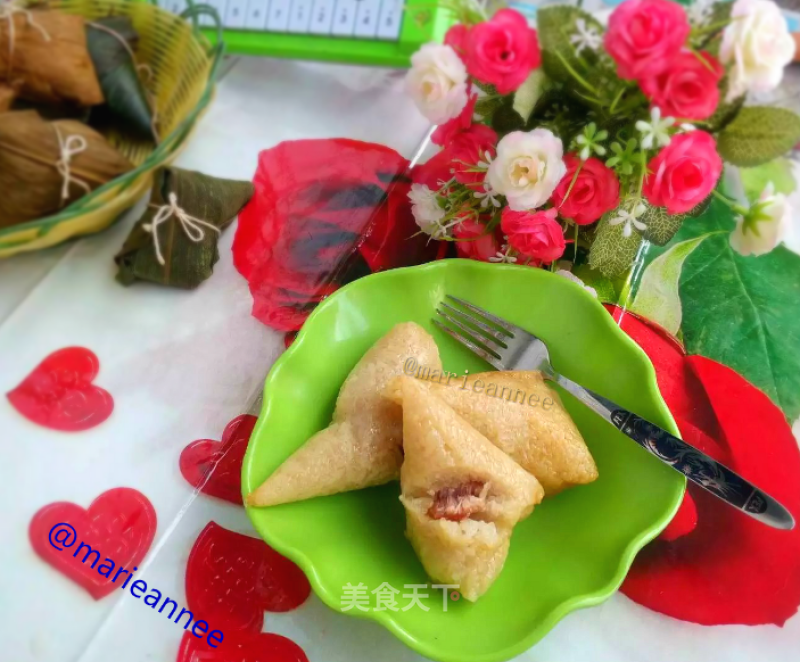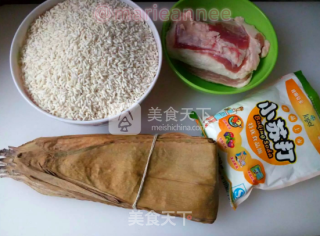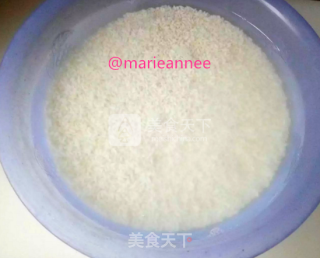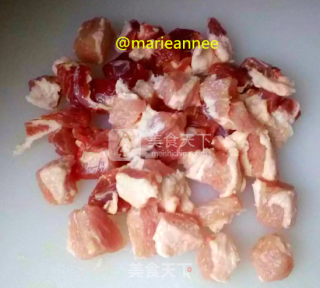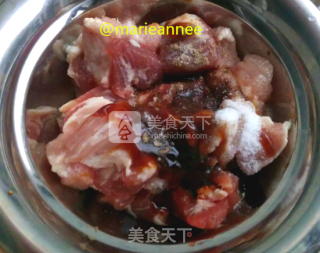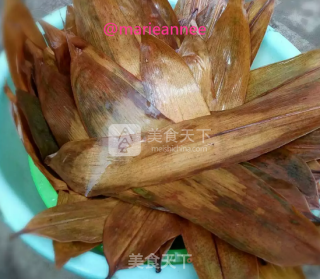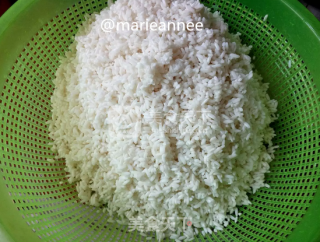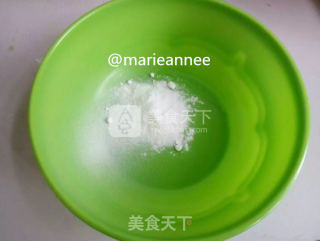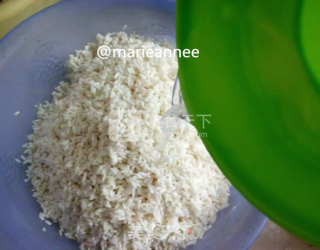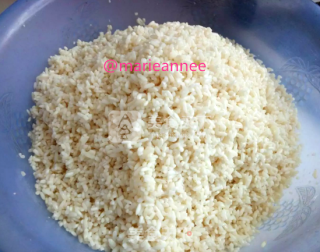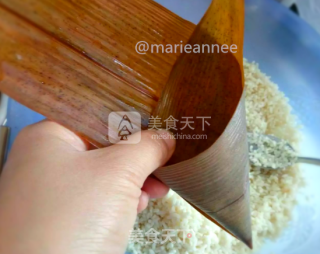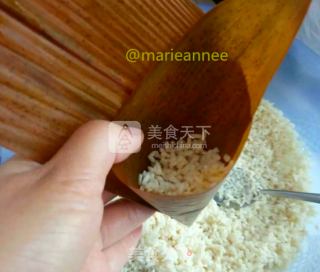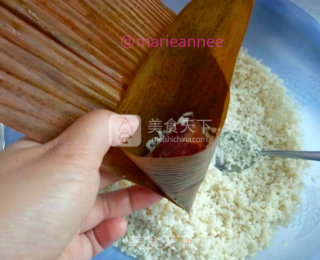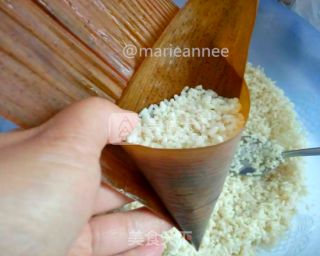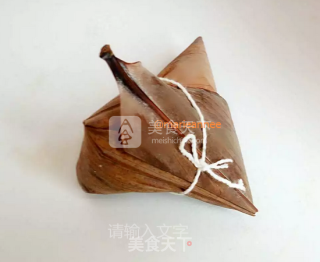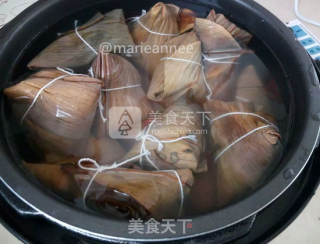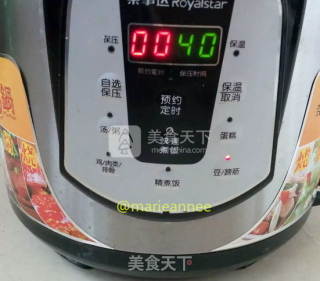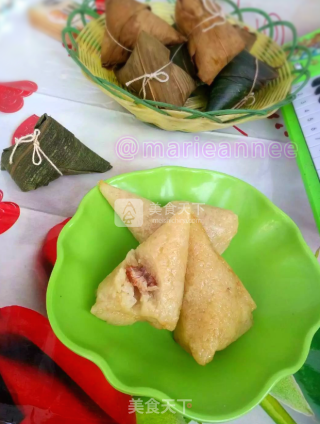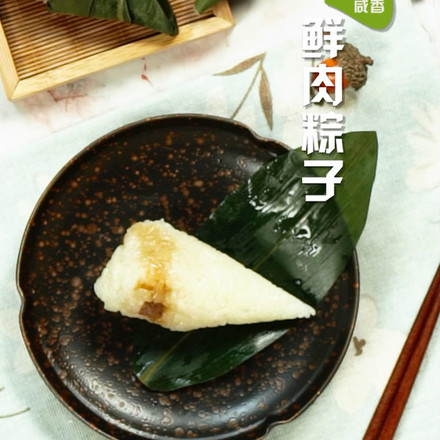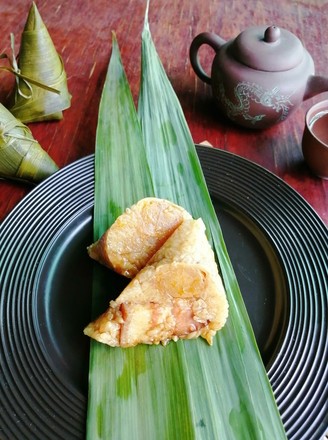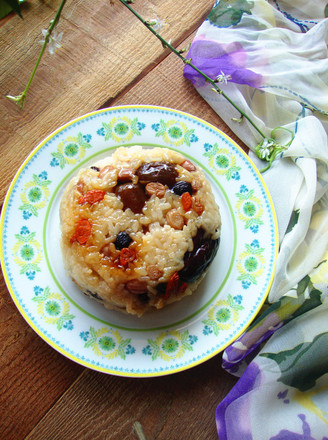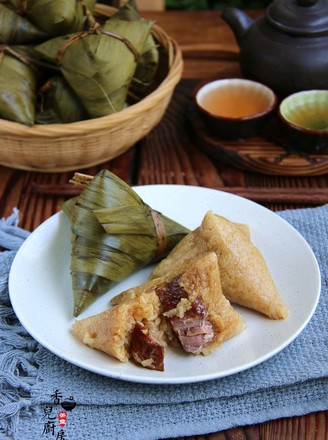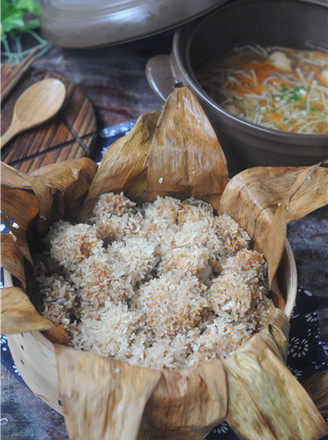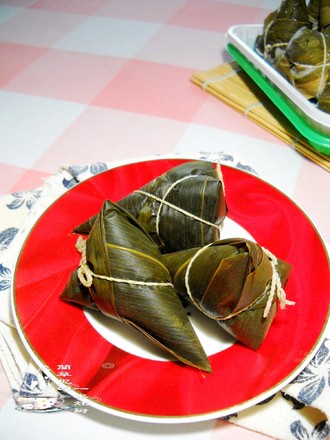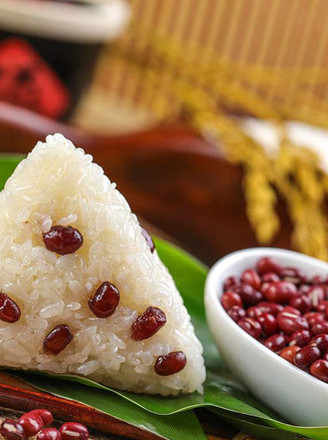Bacon Zongzi
by marieanne
Favorite
Difficulty
Normal
Time
15m
Serving
2
Today is the Dragon Boat Festival of the lunar calendar. Eating zongzi is one of the traditional customs of the Chinese people. Zongzi, also known as "horned rice dumplings" and "tube dumplings". It has a long history, and there are many kinds of tricks. On the morning of the Dragon Boat Festival, every family eats rice dumplings to commemorate Qu Yuan. Usually the rice dumplings are wrapped the day before, cooked at night, and eaten in the morning.
The Dragon Boat Festival is the fifth day of the fifth lunar month. According to "Jing Chu Sui Shi Ji" records, because midsummer ascends high, Shunyang is up, May is midsummer, and its first noon is the day of good weather ascending to Shunyang, so the fifth day of May is also called "Duanyang". Festival". In addition, the Dragon Boat Festival is also called "Wu Sun Festival, May Festival, Dragon Boat Festival, Bath Orchid Festival" and so on. The Dragon Boat Festival is a traditional cultural festival popular in China and other countries in the Chinese character culture circle. The Dragon Boat Festival originated in China. It was originally a totem sacrifice festival for the tribes who worshiped the dragon totem in the ancient Baiyue area (the middle and lower reaches of the Yangtze River and the south). Before the Spring and Autumn Period, there were tribes held in the form of dragon boat races on the fifth day of the fifth lunar month. The custom of totem sacrifice. Later, due to the Warring States Period, Chu (now Hubei) poet Qu Yuan committed suicide by bouldering and jumping on the Miluo River on that day. The ruler used Dragon Boat Festival as a festival to commemorate Qu Yuan in order to establish a patriotic label of loyalty to the emperor.
According to the "Biography of Qu Yuan Jia Sheng" in "Historical Records", Qu Yuan was the minister of Chu Huai during the Spring and Autumn Period. He advocated appointing talents, prospering the country and strengthening the army, and urged to unite against the Qin Dynasty. However, he was strongly opposed by the nobleman Zilan and others. Qu Yuan was greeted by dismissal, was expelled from the capital and exiled to the Yuan and Hunan basins. During his exile, he wrote immortal poems such as "Li Sao", "Heaven Questions", and "Nine Songs", which are concerned about the country and the people, which are unique and have far-reaching influence (hence the Dragon Boat Festival is also called the Poet's Day). In 278 B.C., the Qin Army conquered the capital of Chu. Qu Yuan saw his motherland being invaded, and his heart was cut, but he still couldn't bear to abandon his motherland. On May 5th, after writing his masterpiece "Huaisha", he cast a stone and cast Miluo River to death, with his own life. Compose a magnificent patriotic movement.
Legend has it that after Qu Yuan's death, the people of Chu State were so sad that they flocked to the Miluo River to pay tribute to Qu Yuan. The fishermen rowed boats to salvage his real body back and forth on the river. A fisherman took out the rice balls, eggs and other food prepared for Qu Yuan and threw them into the river "plop and plop", saying that he would eat the fish, lobsters and crabs, so he would not bite the doctor's body. People followed suit after seeing it. An old doctor brought a jar of realgar wine and poured it into the river, saying that he wanted the medicine to stun the dragon water beast, so as not to hurt Dr. Qu. Later, because they were afraid that the rice balls would be eaten by the dragon, people came up with the idea of wrapping rice with neem leaves and wrapping colored silk around them to develop into zongzi.
After that, on the fifth day of May every year, there will be customs of dragon boat racing, eating rice dumplings, and drinking realgar wine; in order to commemorate the patriotic poet Qu Yuan. Since then, Qu Yuan has been famous for many generations, and his patriotic spirit has spread to all parts of China. There are also sayings in some areas to commemorate Wu Zixu and Cao E.
The Dragon Boat Festival, the Spring Festival, the Ching Ming Festival, and the Mid-Autumn Festival are also known as the four traditional festivals of the Chinese Han people.
Since ancient times, Dragon Boat Festival has had festivals such as dragon boating and eating rice dumplings. Since 2008, the Dragon Boat Festival has been listed as a national legal holiday. In May 2006, the State Council included it in the first batch of national intangible cultural heritage lists; in September 2009, UNESCO formally reviewed and approved China’s Dragon Boat Festival to be included in the world’s intangible cultural heritage, becoming China’s first selection of the world’s intangible cultural heritage. Intangible cultural heritage festival.
Eating zongzi, dragon boat racing, and drinking realgar wine during the Dragon Boat Festival have become common behaviors among Chinese people.
Bao Zongzi is mainly made of tender reed leaves or ruo leaves that are abundant in river ponds. Ruoye, commonly known as zongye, grows in the vast mountains and ridges. It has a well-developed root system and strong vitality. It is not only a good vegetation for water and soil protection, but also an inexhaustible wealth. It is a "green bank" for the people in the mountains. ". It can be used not only to wrap rice dumplings, but also to package other foods and table decorations and food foils, and can also be used to weave utensils, make lunch boxes and cut into various shapes. Zong leaves are naturally grown, without any poison or pollution, and can be harvested year after year, harvested in seasons, and used as food packaging, with no pollution and use of "disposable". Therefore, it is called "natural green food" by today's nutritionists. Zongye extract is rich in Zongye polysaccharides, Zongye flavonoids, organic zinc, selenium, iodine, calcium, magnesium, iron, multiple vitamins and amino acids and other nearly 40 functional factors. It has long been recorded in "Compendium of Materia Medica" that Zongye has the effects of clearing heat and stopping bleeding, detoxifying and reducing swelling, and curing vomiting, bleeding, urination, and carbuncle. The "Chinese Medicine Dictionary" also introduces these effects of rice dumpling leaves. In recent years, studies have proved that the polysaccharides in chopsticks leaves also have anti-cancer effects.
The traditional form of zongzi is triangular. It is generally named after the inner crumb. The rice dumpling is called rice dumpling, the rice mixed with red beans is called small bean dumplings, and the red dates are called jujube dumplings, which are collectively called glutinous rice dumplings. The homonym of Zao Zong is "Morning Zong", so the people who eat Zao Zong are the most. Children who intend to read can get the top spot in the early. In the past, scholars had to eat jujube rice dumplings in the morning on the day they took the imperial examinations. Today, on the morning of entrance examination days for middle schools and universities, parents also have jujube rice dumplings for test takers.
Bacon Zongzi is a famous snack of Han nationality in Jiangnan area. The bacon dumplings I packaged today are not very good because it is the first package, but the smell is rich and fragrant, oily and delicious, it is really delicious. Those who like meat and salty rice dumplings can try it! "
The Dragon Boat Festival is the fifth day of the fifth lunar month. According to "Jing Chu Sui Shi Ji" records, because midsummer ascends high, Shunyang is up, May is midsummer, and its first noon is the day of good weather ascending to Shunyang, so the fifth day of May is also called "Duanyang". Festival". In addition, the Dragon Boat Festival is also called "Wu Sun Festival, May Festival, Dragon Boat Festival, Bath Orchid Festival" and so on. The Dragon Boat Festival is a traditional cultural festival popular in China and other countries in the Chinese character culture circle. The Dragon Boat Festival originated in China. It was originally a totem sacrifice festival for the tribes who worshiped the dragon totem in the ancient Baiyue area (the middle and lower reaches of the Yangtze River and the south). Before the Spring and Autumn Period, there were tribes held in the form of dragon boat races on the fifth day of the fifth lunar month. The custom of totem sacrifice. Later, due to the Warring States Period, Chu (now Hubei) poet Qu Yuan committed suicide by bouldering and jumping on the Miluo River on that day. The ruler used Dragon Boat Festival as a festival to commemorate Qu Yuan in order to establish a patriotic label of loyalty to the emperor.
According to the "Biography of Qu Yuan Jia Sheng" in "Historical Records", Qu Yuan was the minister of Chu Huai during the Spring and Autumn Period. He advocated appointing talents, prospering the country and strengthening the army, and urged to unite against the Qin Dynasty. However, he was strongly opposed by the nobleman Zilan and others. Qu Yuan was greeted by dismissal, was expelled from the capital and exiled to the Yuan and Hunan basins. During his exile, he wrote immortal poems such as "Li Sao", "Heaven Questions", and "Nine Songs", which are concerned about the country and the people, which are unique and have far-reaching influence (hence the Dragon Boat Festival is also called the Poet's Day). In 278 B.C., the Qin Army conquered the capital of Chu. Qu Yuan saw his motherland being invaded, and his heart was cut, but he still couldn't bear to abandon his motherland. On May 5th, after writing his masterpiece "Huaisha", he cast a stone and cast Miluo River to death, with his own life. Compose a magnificent patriotic movement.
Legend has it that after Qu Yuan's death, the people of Chu State were so sad that they flocked to the Miluo River to pay tribute to Qu Yuan. The fishermen rowed boats to salvage his real body back and forth on the river. A fisherman took out the rice balls, eggs and other food prepared for Qu Yuan and threw them into the river "plop and plop", saying that he would eat the fish, lobsters and crabs, so he would not bite the doctor's body. People followed suit after seeing it. An old doctor brought a jar of realgar wine and poured it into the river, saying that he wanted the medicine to stun the dragon water beast, so as not to hurt Dr. Qu. Later, because they were afraid that the rice balls would be eaten by the dragon, people came up with the idea of wrapping rice with neem leaves and wrapping colored silk around them to develop into zongzi.
After that, on the fifth day of May every year, there will be customs of dragon boat racing, eating rice dumplings, and drinking realgar wine; in order to commemorate the patriotic poet Qu Yuan. Since then, Qu Yuan has been famous for many generations, and his patriotic spirit has spread to all parts of China. There are also sayings in some areas to commemorate Wu Zixu and Cao E.
The Dragon Boat Festival, the Spring Festival, the Ching Ming Festival, and the Mid-Autumn Festival are also known as the four traditional festivals of the Chinese Han people.
Since ancient times, Dragon Boat Festival has had festivals such as dragon boating and eating rice dumplings. Since 2008, the Dragon Boat Festival has been listed as a national legal holiday. In May 2006, the State Council included it in the first batch of national intangible cultural heritage lists; in September 2009, UNESCO formally reviewed and approved China’s Dragon Boat Festival to be included in the world’s intangible cultural heritage, becoming China’s first selection of the world’s intangible cultural heritage. Intangible cultural heritage festival.
Eating zongzi, dragon boat racing, and drinking realgar wine during the Dragon Boat Festival have become common behaviors among Chinese people.
Bao Zongzi is mainly made of tender reed leaves or ruo leaves that are abundant in river ponds. Ruoye, commonly known as zongye, grows in the vast mountains and ridges. It has a well-developed root system and strong vitality. It is not only a good vegetation for water and soil protection, but also an inexhaustible wealth. It is a "green bank" for the people in the mountains. ". It can be used not only to wrap rice dumplings, but also to package other foods and table decorations and food foils, and can also be used to weave utensils, make lunch boxes and cut into various shapes. Zong leaves are naturally grown, without any poison or pollution, and can be harvested year after year, harvested in seasons, and used as food packaging, with no pollution and use of "disposable". Therefore, it is called "natural green food" by today's nutritionists. Zongye extract is rich in Zongye polysaccharides, Zongye flavonoids, organic zinc, selenium, iodine, calcium, magnesium, iron, multiple vitamins and amino acids and other nearly 40 functional factors. It has long been recorded in "Compendium of Materia Medica" that Zongye has the effects of clearing heat and stopping bleeding, detoxifying and reducing swelling, and curing vomiting, bleeding, urination, and carbuncle. The "Chinese Medicine Dictionary" also introduces these effects of rice dumpling leaves. In recent years, studies have proved that the polysaccharides in chopsticks leaves also have anti-cancer effects.
The traditional form of zongzi is triangular. It is generally named after the inner crumb. The rice dumpling is called rice dumpling, the rice mixed with red beans is called small bean dumplings, and the red dates are called jujube dumplings, which are collectively called glutinous rice dumplings. The homonym of Zao Zong is "Morning Zong", so the people who eat Zao Zong are the most. Children who intend to read can get the top spot in the early. In the past, scholars had to eat jujube rice dumplings in the morning on the day they took the imperial examinations. Today, on the morning of entrance examination days for middle schools and universities, parents also have jujube rice dumplings for test takers.
Bacon Zongzi is a famous snack of Han nationality in Jiangnan area. The bacon dumplings I packaged today are not very good because it is the first package, but the smell is rich and fragrant, oily and delicious, it is really delicious. Those who like meat and salty rice dumplings can try it! "

